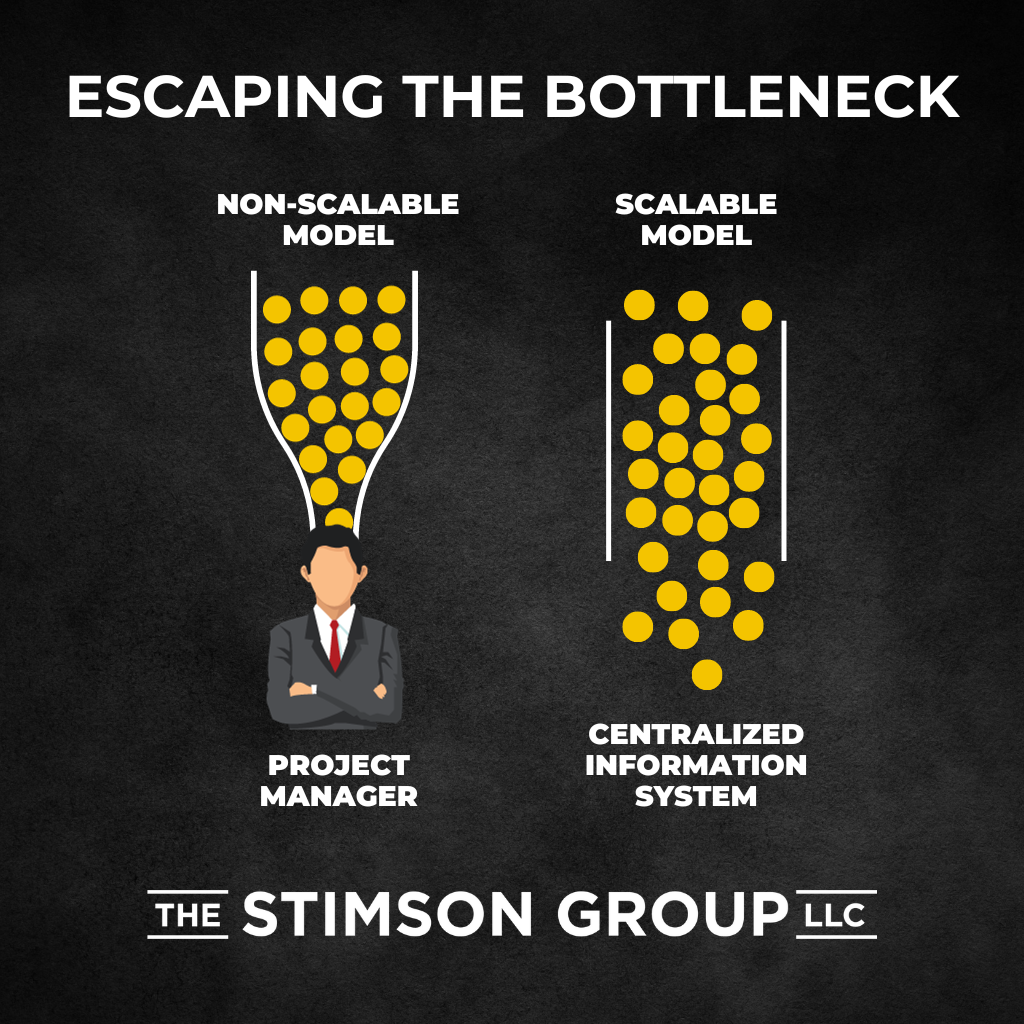
Listen instead on your Monday Morning Drive:
I recently spoke to a client who’s on the road to scalability. So far, he’s created clear selling, planning, and admin spheres, and all his employees understand their roles. That’s great.
However, while he has all the functions of a planning sphere in place, planning itself isn’t easier. He called me to ask why.
I told him, “If planning isn’t easier, you either lack a scalable planning unit or misunderstand what planning is. Once you do, it’ll be easier to get work done.”
I went on.
Escaping the Bottleneck
In a non-scalable model, project planning often relies on a single dominant figure.
Meet Wade, our hypothetical project manager. Whenever I close a job, I tell Wade about it, trusting that he’ll handle it. This approach seems easy and time-efficient — you always know who to ask! And because Wade is great at his job, you don’t need to spend time developing systems or processes.
The problem is that even the best project manager has limited capacity. As your firm grows, you hire one Wade after another. Now you have 10 Wades, each with their own way of doing things, and no one to reconcile the conflicting needs of all the Wades.
This is how most companies in our industry have solved their process problems over the years: by hiring more experts without ever identifying the common practices within the organization.

Transitioning to a Scalable Planning Model
Only one person at a time has access to Wade’s brain, but a scalable planning model works from a single source of truth accessible to everyone in the organization. If data about each project is captured in a centralized system like a CRM, information can flow freely without bottlenecking behind one person.
For example, in a scalable planning model, by the time I’ve sold a new job, others have already assessed it. When I log a sale in our system, the status change from “LIKELY” to “CONFIRMED” automatically informs relevant team members to proceed with their portions of the work.
Rather than waiting for Wade to delegate tasks, the team moves forward organically by monitoring this single source of truth.
Greater Efficiency Through Parallel Work
Let’s talk about the difference between information pull systems and information push systems.
- In an information push system, we wait for somebody to push information through so we know what to do next. When prompted, the surprised recipient may throw their hands up and say, “I’m too busy! I can’t do that yet!”
- In an information pull system, we wait for enough information to exist so we can pull it away from the previous process. We consult the CRM and say, “I see what I need to do. I have to get the resources to get this done.”
The transition to a scalable model — an information pull system — unlocks greater efficiency. Instead of operating in a rigid series, steps can happen in parallel. While Wade can still oversee quality and continuity, planning activities no longer bottleneck behind his capacity.
The central source of truth acts as an automated coordinator, allowing team members to accomplish more in less time. Now, Wade’s job is to continue to curate the source of truth.

Avoiding Common Mistakes
Of course, transitioning to this model comes with growing pains if not managed carefully. Two common missteps throw things off track:
- Team members might haphazardly jump into tasks beyond their roles. While occasionally necessary, ad hoc task shifting often spawns confusion, delays, and more work for other people. Explicit agreements clarify appropriate flexibility.
- Over-detailing processes, rather than simply focusing on the processes’ outputs, can cause needless slowdowns.
Imagine you’re in the middle of a show, and you’re part of an eight-person crew on headset. In the middle of the show, during the CEO’s speech, the A1 shouts into the headset, “I have an emergency!” He throws his headset off and leaves.
According to your process, you need to get another person to fill the A1’s role. In the moment, that isn’t feasible. The most qualified person in the eight-person crew quickly fills the A1’s position, and the next most qualified person fills theirs, and so on, until everyone’s bases are covered.
That’s the beauty of the scalable model. Focusing on required outputs makes room for situational fluidity within structured expectations. Defining goals beyond step-by-step protocols prevents process rigidity.
With a balanced approach, scalable planning transforms previously isolated efforts into an integrated machine, simplifying operations enormously. The change takes courage and commitment, but when done right, it alleviates so many pains familiar across our industry.





Leave a Reply